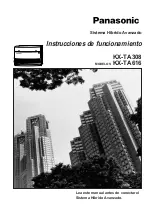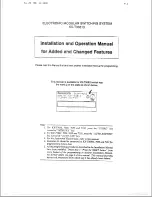
MERLIN LEGEND Communications System Release 5.0
Feature Reference
555-650-110
Issue 1
June 1997
Features
Page 167
Coverage
Single-Line Telephones
9
A single-line telephone can be a sender for either Individual or Group Coverage. A
single-line telephone can be a receiver for Individual Coverage. It can be a
receiver for Group Coverage only when it is a member of a calling group assigned
as a receiver for a coverage group.
Transferred calls to a busy single-line telephone are not eligible for coverage
unless Coverage Inside is on. A transferred call to a busy single-line telephone
with Group Coverage and Coverage Inside off camps on at the single-line
telephone and returns to the originator if not answered before the transfer return
interval expires.
Feature Interactions
9
Account Code Entry
When answering calls on a programmed Primary Cover, Secondary
Cover, or Group Cover button, a receiver cannot enter an account code.
When attempting to enter an account code, the receiver hears no error
tone, but the account code does not appear on the SMDR report.
Because Cover buttons are not required when the QCC queue is
assigned as a receiver for a coverage group, a QCC operator can enter
an account code, and the account code appears on the SMDR printout.
Auto Answer All
A sender or receiver at an analog multiline telephone can use Auto
Answer All to have calls answered by an answering machine connected
to the telephone.
Auto Answer
Intercom
Auto Answer Intercom prevents a receiver on an analog multiline
telephone from using a Hands-Free Unit (HFU) to answer calls received
on a Primary Cover, Secondary Cover, or Group Cover button.
Automatic Line
Selection
Primary Cover, Secondary Cover, and Group Cover buttons cannot be
programmed in an ALS sequence because they cannot make calls.
Barge-In
Barge-In can be used to join an Individual or Group Coverage call
answered at any receiver telephone, but not at a VMI port. VMI ports
always have Privacy on.
Callback
The sender and all receivers must be busy before a call to a sender is
eligible for Callback. The call is sent to coverage before it is put in the
callback queue. Once a call is in the callback queue, it is not sent to
coverage again. A callback call indicating that a busy extension or pool is
now available is not sent to coverage.
Caller ID
Caller ID information is available to users receiving coverage calls.
Calling Restrictions
In Release 2.1 and later systems, users answering calls on Cover buttons
can generate touch tones (for example, by dialing a
1
to accept a collect
call) if their telephones are not outward- or toll-restricted. If the telephone
is outward- or toll-restricted, the user hears the touch tones, but the tones
are not sent out over the line (and the user cannot, for example, accept
collect calls by dialing a
1
).
















































